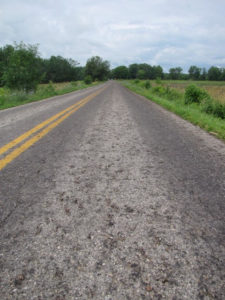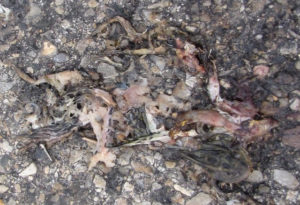Northern Leopard Frog-pocalypse? No, but…
Over the past week I have received many e-mails, phone calls, and reports of huge numbers of small frogs along the Otter Creek floodplains of Cornwall, Leicester, and Salisbury. Landowners report not wanting to mow their lawns; pool owners have reported hundreds of small frogs in their pools; and drivers report the tremendous carnage on the road surface. I visited Creek Road in Salisbury today and found the road covered with the bones, fluids, and bodies of dead Northern Leopard Frogs.

 The tire tread areas of the road are covered with a solid black surface of frog bodily fluids. I estimated about 100 dead frogs per square yard of road surface were visible where the car tires hit the roads. This translates to a minimum of 400,000 dead frogs for the 1/2 mile section of Creek Road from the railroad tracks to Otter Creek. As a result of the heat and tremendous density of body fluids and parts, the area literally stinks. Still, despite the number of dead frogs on the road, the road edges were still hopping with thousands of young living frogs.
The tire tread areas of the road are covered with a solid black surface of frog bodily fluids. I estimated about 100 dead frogs per square yard of road surface were visible where the car tires hit the roads. This translates to a minimum of 400,000 dead frogs for the 1/2 mile section of Creek Road from the railroad tracks to Otter Creek. As a result of the heat and tremendous density of body fluids and parts, the area literally stinks. Still, despite the number of dead frogs on the road, the road edges were still hopping with thousands of young living frogs.

Remains of Northern Leopard frogs on a road in Salisbury Vermont. July, 2019. Photo courtesy of James Andrews.
Northern Leopard Frogs are unusual among our local frogs. They thrive primarily in the Lake Champlain Basin where there is a combination of permanent water, adjacent floodplains, and nearby fields. They overwinter underwater. Along Creek Road that means they overwinter in Otter Creek and in the larger ditches draining into it. In the early spring they travel out into the shallow and warmer waters of the flooded fields, backwaters, and ditches along the creek where they lay egg masses of 1000 eggs or more per mass. In most years, a large percentage of the fields and back waters would dry out before the young tadpoles were ready to leave the water. This year, due to our increased rainfall, that was not the case, and most of those tadpoles are now transforming into young frogs and leaving the water. As a result, longtime residents are reporting more young Northern Leopard Frogs then they have ever seen. Terms like frog-armageddon have been used. I personally suspect that these unusually high numbers are the result of the increasing amount of rainfall that we have been receiving, not just this year, but for the last decade.
This is the only species of frog that uses this combination of habitat types, and consequently is the only species emerging in these huge numbers. I expect that Northern Leopard Frogs may show up in large concentrations in other flood lands along the larger rivers of the Lake Champlain Basin. Northern Leopard Frogs are at the bottom of the food chain, and fish, herons, crows, gulls, hawks, raccoons, snakes; and other predators and scavengers will all be taking advantage of an abundant food supply for the next few weeks.


[…] also have been seeing this year’s young of Northern Leopard Frogs, but in no where near the explosive numbers of last year. Young Spring Peepers and Wood Frogs are usually harder to find and I have received only a […]